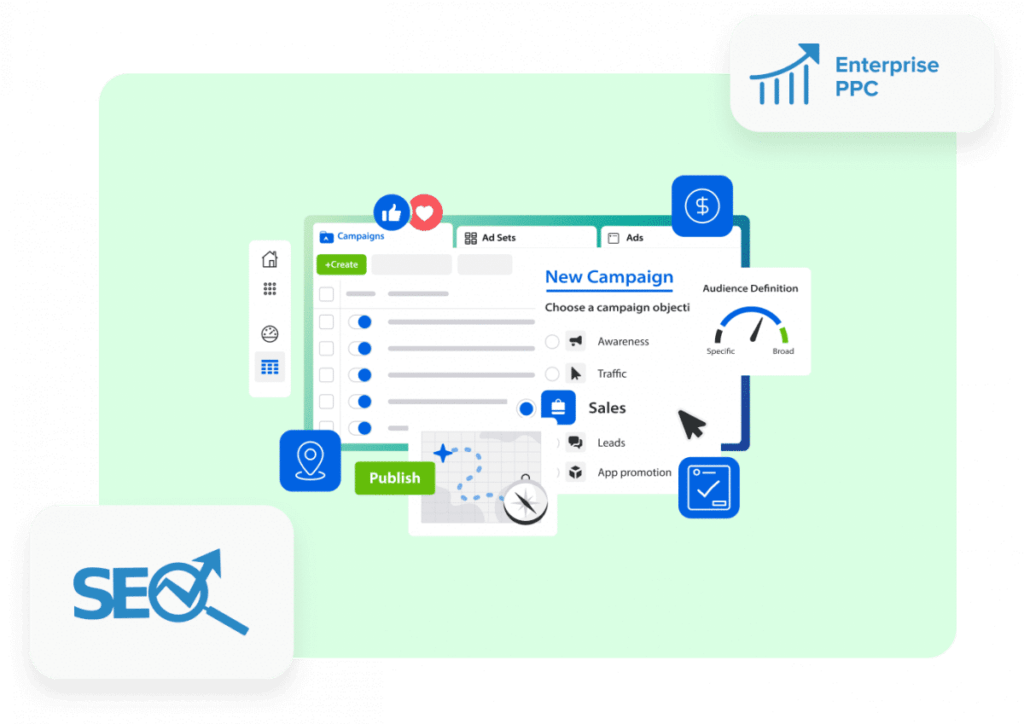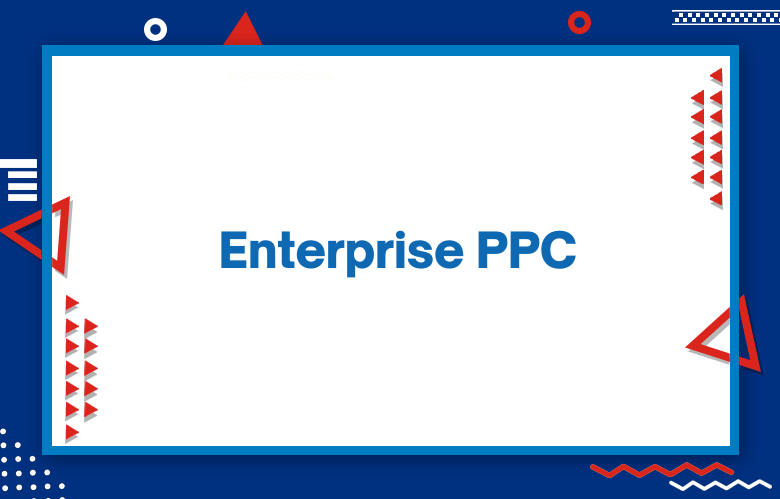PPC Enterprise – Unlocking the Power of Scalable Advertising
Paid ads that grow along with your business can change the game, helping you reach tons of people without spending a fortune. By adjusting their ads, businesses catch more eyes and save cash. It’s like throwing out a big fishing net and hauling in plenty without draining your wallet. Want to know how these smart moves can boost your business? Discover the secrets to winning at marketing without blowing your budget.
What is PPC Enterprise and How It Differs from Standard PPC
| PPC Enterprise | Standard PPC |
| Has features designed for large-scale campaigns that require managing multiple campaigns and ad groups across multiple platforms. Typically used by large businesses or organizations with substantial budgets and a need for more sophisticated strategies | Features that focus on managing individual campaigns with less complexity and scale. More suitable for small and medium businesses with simpler needs. |
| Provides in-depth analytics and reporting, providing detailed insights into campaign performance, ROI and user behavior. | Provides basic reporting and metrics that focus on key performance indicators (KPIs). Provides less detailed insights than enterprise-level analytics. |
Key Benefits of Using PPC Enterprise Solutions

You can take advantage of various key benefits of using PPC Enterprise solutions, including:
Scalability:
Providing enterprise PPC solutions designed to handle large-scale campaigns across multiple platforms, making it ideal for businesses with extensive advertising needs.
Advanced Automation:
Leveraging sophisticated automation and AI to optimize bidding strategies, audience segmentation, and ad placement, increasing efficiency and effectiveness.
Comprehensive Analytics:
Enterprise PPC provides in-depth analytics and reporting, offering detailed insights into campaign performance, user behavior, and ROI. This helps in making data-driven decisions.
Customized Strategies:
Strategies tailored to complex business objectives and market conditions are developed, allowing for more precise and effective targeting.
Choosing the Right PPC Enterprise Platform for Your Business

Here are key factors to consider when determining a good PPC Enterprise for your business:
Feature set – Able to review the availability of advanced tools and features such as automated bidding, AI-based optimization, and in-depth analytics. You must choose a platform that offers sophisticated automation and analytics capabilities to maximize efficiency and performance.
Integration capabilities – Check if the platform integrates seamlessly with other marketing tools and CRM systems. You should integrate with existing tools to enhance data synchronization and simplify campaign management.
Pricing structure – Able to analyze the platform’s pricing structure, including additional fees or other costs. Make sure the costs are in line with your budget and provide value for the features and support offered.
Customer support options – You must consider the level of customer support provided, including availability and expertise. Reliable and responsive support is crucial for effectively handling issues and optimizing campaigns.
Advanced Targeting Techniques in PPC Enterprise
Here are some key techniques used in PPC Enterprise:
Behavioral Targeting, able to target users based on their online behavior, such as browsing history, previous searches, and interactions on websites.
Demographic Targeting, targeting users based on demographic factors such as age, gender, income level, and education.
Contextual Targeting, displaying ads on websites or content relevant to keywords or topics related to the ad.
Remarketing, targeting, users who have previously visited your website or interacted with your brand but did not complete the desired action.
Strategies for Optimizing PPC Campaigns for Large-Scale Operations
Optimizing PPC campaigns for large-scale operations involves implementing strategies that address the complexity and scale of extensive campaigns by considering several things below:
Advanced Keyword Research
Conduct comprehensive keyword research to identify high-value and long-tail keywords relevant to your business. Use keyword tools to continuously update and refine your keyword list.
Granular Segmentation and Targeting
Segment your campaigns and ad groups based on various criteria such as geography, device, demographics, and user behavior. Create granular targeting to meet the specific needs and interests of various audience segments.
Automated Bidding and AI Optimization
Use automated bidding strategies and AI-driven tools to optimize bids in real-time based on performance data. Apply machine learning algorithms to adjust bids, manage budgets, and improve ad performance.
The Role of Automation in PPC Enterprise Management
Here’s how automation affects PPC Enterprise management:
Automated Bidding Strategies:
Adjusting bids in real-time based on performance metrics and competitive data. This helps optimize ad spend and maximize ROI without constant manual intervention.
Ad Creation and Testing:
Can automatically generate and test various ad variations based on predefined rules and performance data.
Data-Based Bid Adjustments:
Automation adjusts bids based on various data inputs, including time of day, device, location, and user behavior.
Automated Reporting and Analytics:
As an automation tool generates detailed reports and analytics on campaign performance without manual data entry.
Measuring Success: Key Metrics for PPC Enterprise Campaigns
Measuring the success of PPC Enterprise campaigns involves tracking various key metrics to assess performance, efficiency, and ROI. Here are some important metrics to consider:
Cost Per Acquisition (CPA)
As the average cost to acquire a customer or prospect through your PPC campaign. A lower CPA indicates more cost-effective acquisition.
Customer Lifetime Value (CLV)
A metric used to estimate the total revenue a business can expect from a customer over the duration of their relationship. Helps businesses understand how valuable each customer is in the long term.
Click-Through Rate (CTR)
The ratio of users who click on your ad compared to the number of users who view it. A higher CTR indicates that your ad is attractive and relevant.
Return on Investment (ROI)
A financial metric used to evaluate the efficiency or profitability of an investment. This metric measures profit relative to investment cost, helping to assess how effectively resources are used to generate profit.
Common Challenges in PPC Enterprise and How to Overcome Them
Some challenges that exist in PPC Enterprise and how to overcome them are:
Budget constraints
Able to allocate and optimize large advertising budgets effectively using automated bidding strategies and regular performance reviews to dynamically adjust budgets based on campaign performance.
Campaign complexity
Coordinate and optimize many campaigns and ad groups across multiple platforms by implementing advanced campaign management tools and automation to simplify processes and ensure consistency.
Lack of expertise
Lack of expertise in managing enterprise PPC campaigns can result in less effective strategies, suboptimal budget management, and unsatisfactory results. The way to do this is through training and education by investing in training for marketing and advertising teams.
Future Trends in PPC Enterprise Advertising
Future Trends in PPC Enterprise Advertising include Artificial Intelligence and Machine Learning AI and ML to improve ad targeting, optimize bidding strategies, and generate more effective ad copy. Voice Search Optimization by adjusting PPC strategies to handle increasingly popular voice search queries. Video Ads as an increase in investment in video ads along with the dominance of video content in digital media.
Conclusion
PPC Enterprise has features designed for large-scale campaigns that require managing many campaigns and ad groups across multiple platforms. Typically used by large businesses or organizations with substantial budgets and the need for more sophisticated strategies. Able to review the availability of advanced tools and features such as automated bidding, AI-based optimization, and in-depth analytics. Thus determining the choice of platforms that offer sophisticated automation and analytics capabilities to maximize efficiency and performance.
